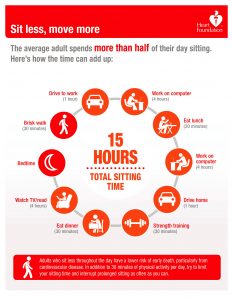The World Health Organisation (WHO) defines physical activity as any bodily movement produced by the muscular system that requires the expenditure of energy. It has been well document within scientific literature that physical activity leads to significant health benefits including the reduced risk of cardiovascular disease, obesity, diabetes and cancer.
In order to realise these benefits, the WHO have outlined the following recommendations for physical activity and sedentary behaviour:
- 150 minutes of moderate-intensity or 75 minutes of vigorous-intensity physical activity per week
- Resistance training on 2 or more days per week
- Adolescents: spend no more than 2 hours per day on electronic media for entertainment
- Adults: minimise the amount of time sitting and break up long periods of sitting as often as possible
However, it is important to understand that these recommendations for physical activity and sedentary behaviour go hand in hand to achieve the desired benefits of a healthy lifestyle, meaning you can’t out train a sedentary lifestyle. Participating in physical activity for an hour before or after work unfortunately doesn’t negate the negative effects of sitting for 8 hours at work per day, which is why it is important to break up long periods of sitting as often as possible.
In 2010 alarming statistics found that 1 in 4 adults are not active enough and over 80% of adolescents are not participating in enough physical activity, which is linked to 1 of the 10 leading risk factors for mortality worldwide.
Sitting for long periods of time can increase your risk of many lifestyle diseases such as obesity, cardiovascular disease, diabetes and premature death as well as decrease mental health and wellbeing.
So how can I reduce my sitting time…
At Home:
- Complete 10 sit to stands during each add break when watching TV
- Complete household tasks when watching the TV
- Plan water or bathroom breaks every hour when studying
At Work:
- Take a smaller drink bottle to fill up more often
- Incorporate standing tasks between sitting tasks throughout the day
When Travelling:
- Offer your seat up on public transport
- Get off one stop early and walk the extra distance
- Plan regular breaks when travelling long distances
For more information of the Physical Activity and Sedentary Behaviour Guidelines;
For more information on the risks of increased sedentary behaviour;

Written by May Warrick AEP (Accredited Exercise Physiologist)
